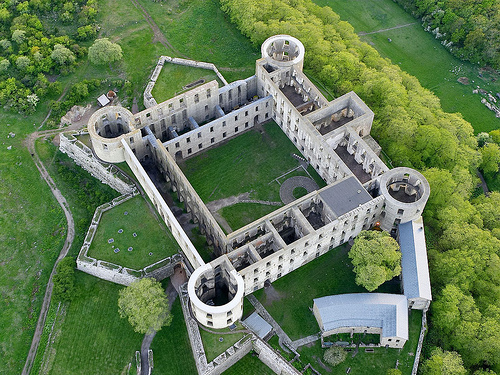

Location: Borgholm Map
Constructed: 12th century with subsequent improvements
Borgholm Castle (in Swedish: Borgholms slott) is historic medieval citadel situated in Borgholm of Sweden. Borgholm Castle was originally constructed in the 12th century. It is linked to Halltorps, to the south. The castle was destroyed in a fire on October 14, 1806. The construction of the original fortress was probably ordered by King Canuto I, although this is not entirely certain. He reigned between 1167 and 1195 and had fortresses built on the east coast of Sweden as a defense against enemies on the other side of the Baltic Sea. Subsequent modernization and reconstruction greatly changed the appearance of Borgholm Castle.
Borgholm Castle is located just outside Borgholm in Borgholm, in the northern half of Öland Island. It dominates the Landborg cliff, reaching about 25 m above the surrounding land. This cliff draws a curve precisely at the site of the castle, creating a natural defense against enemies from the west and north. This allowed the castle to monitor the Kalmar Strait, separating the island from the Swedish coast of Småland. On the east and south side is an alvar, a kind of limestone moor.
At the end of the 12th century, a mighty tower was built, a castle,
which was soon surrounded by a ring wall. The castle was built during
the latter part of the 13th century and should have been completed in
1281. The importance of Borgholm Castle and Öland should be seen
militarily, along the sea roads between north and south, given its
position opposite Kalmar, which during the Union period served as an
important meeting place for councilors from the three Nordic kingdoms,
and also thanks to the proximity to Gotland, another strategic place
worth checking out in the Baltic Sea.
During the wars between
Sweden and Denmark, the castle was destroyed in the early 16th century
and was not rebuilt until the reign of Johan III.
From 1572,
first Johan Baptista Pahr and then his brother Dominicus was the builder
of the castle, which then became one of Sweden's first bastion
fortresses. Work on the castle ceased in 1593, at Duke Karl's command,
but in 1602 the fortifications began to be strengthened, and thus
continued until the outbreak of the Kalmar War. On August 8, 1611, the
castle was enclosed by the Danes, and the very next day it was abandoned
by its commander, Johan Månsson, but on September 27, 1611, it was
surrounded by Gustaf Adolf, who, however, did not until October 7
succeed in persuading the Danish commander Kristen Hansen to capitulate.
June 2, 1612, the Danes returned and after 9 days of shelling, the
castle was handed over by Peder Mikaelsson Hammarskjöld to Gert Rantzau.
After the peace in Knäred in 1613, it was returned in looted and
badly damaged condition, so that repair work must begin. However, these
were discontinued after about ten years. However, a small earthworks was
built in 1643, and from 1651, when Öland was granted to Karl Gustav, the
castle building was continued under the leadership of Nicodemus Tessin
the Elder. When war with Denmark broke out again, Borgholm's castle was
so fortified that Captain Henrik Julius Heideman could defend it against
the Danes, who on 17 August attempted a storm. The following day, the
castle was rescued by Admiral Wachtmeister, who drove out the Danes.
Construction work stopped after Karl X Gustav's death in 1660. They
were resumed in 1681 but were soon closed again. The castle was
therefore never completed according to Tessin's plan, and Erik
Dahlbergh's stately drawing in Suecia antiqua et hodierna is thus
incorrect. Eventually, the finished part of the castle also fell into
disrepair. Towards the end, the last usable premises included a school
and textile dyeing. October 14, 1806, a wildfire completed the
destruction plant.